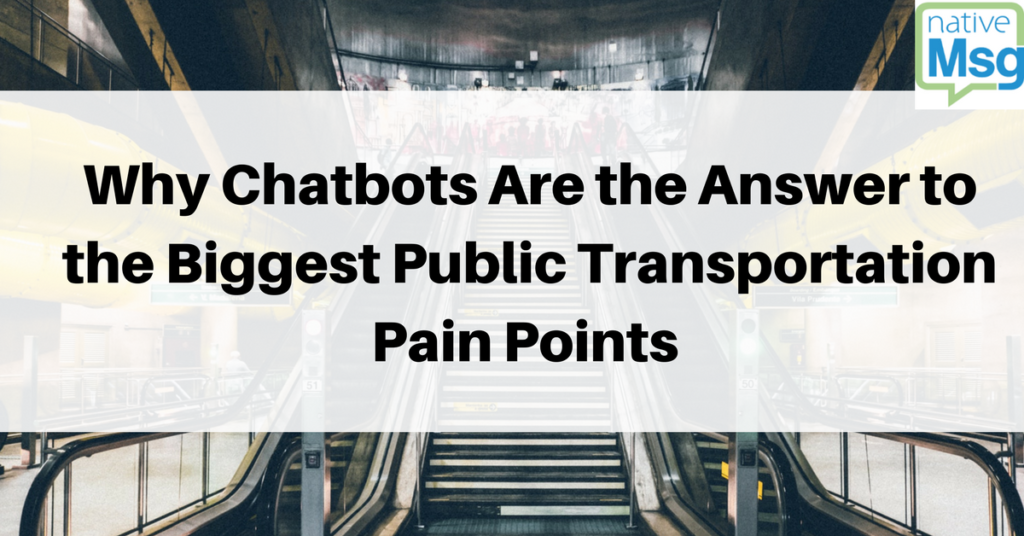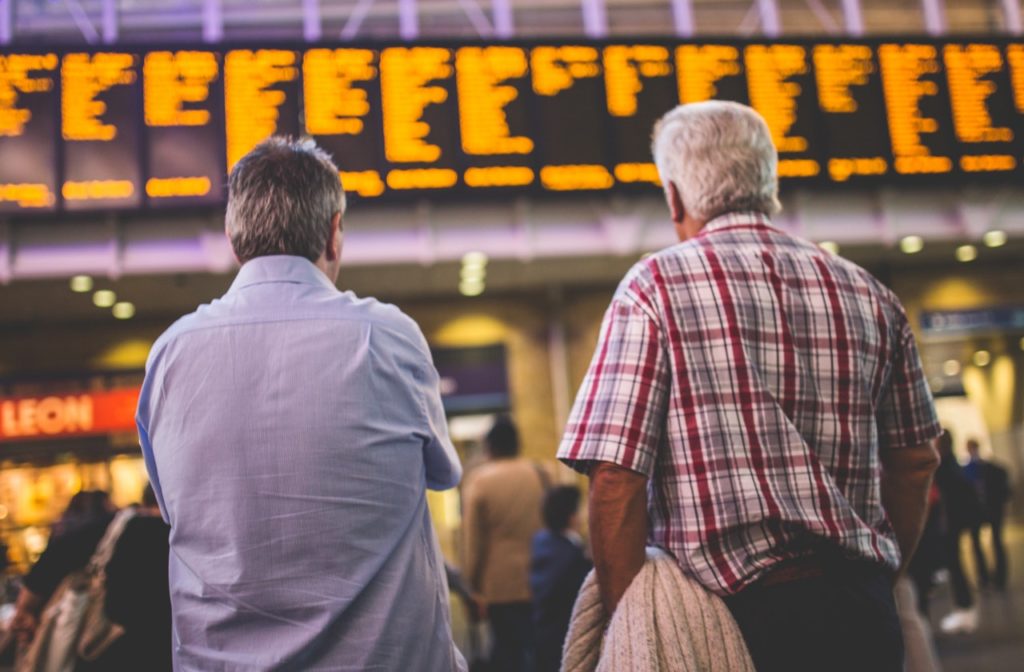
Can chatbot transportation services really be the answer to public transportation and infrastructure woes? Chatbot and (IoT) internet of things are a powerful solution in the short term. Here’s how:
The Case for Chatbot Transportation Services
Millions of people ride public transportation everyday and Americans take over 10 billion rides on public transportation each year, reports The American Public Transportation Association (APTA). But public transportation ridership is down while costs have steeply risen to maintain trains, buses and rail.
Likewise, while most commuters are local professionals, business travelers are also affected by poor infrastructure. These travelers across all continents count “time in transit” as the top annoyance and frustration in travel, according to Skift.com.
Given this bleak landscape, it would seem today’s public transport remains an indelible, necessary hassle for commuter and business travel work-life.
But chatbots offer a solution to this. Conversational AI provides a way to upgrade rider experience, reduce this hassle and to keep spending much lower; it’s an excellent intermediary solution toward a longer-term, essential upgrade.
Biggest Challenges in Public Transport in 2018
According to the WBUR.org, ridership across many metro areas, including Chicago, Austin, Los Angeles, Washington D.C and New York has been down. If you take all metro areas as a group, Washington D.C. greatly impacts this average with a system that’s been in decline because of “long-term problems,” though similar problems exist in many cities.
The challenge to upgrade is steep. To create a commuter and user-friendly transportation system, making physical upgrades is a monumental pursuit. In Chicago alone, upgrade spend is in the billions. Across the country, extensive repairs, new trains, and inter-agency approval stalls the process.
Across the board, the most common problems include unreliability, neglect, deteriorating infrastructure, deep overcrowding. Likewise, a lack of partnering between transportation agencies in regulation also hinders progress.
When commuters need to use multiple forms of transportation, including metro and bus systems, it becomes a major inconvenience to do so without reliable schedules and updates. That’s particularly in areas where temperatures plummet and commuters are left to wait for connections.
Here’s How Chatbots Can Ease Commuter Stress, Now

Ironically, with all the advances in digital technology, this transit has not kept pace. Commuters have bared the brunt. The commuter experience includes hard-to-read transit schedule data, missed connections, crowded trains, and slowed commutes.
Online schedules in many instances are clunky, involving multi-step input attributes to gain a simple answer.
In 2018, in large metropolitan areas with more than two million people, train and bus lines continue to use poorly designed user-sites and transportation scheduling software. Many have pdf-based schedules, and separate links to each rail line. In some instances, there are separate sites for bus and rail.
This leaves commuters with the annoying job of cross referencing what lines go nearest to their destinations. If a stop is not close by, commuters need to perform the same, time-intensive search again for a bus or alternate transport connection.
Factor in frigid temps to this process and it’s enough to make anyone abandon the process.
In the age of digital convenience, it’s a no-brainer for transportation agencies and companies to use chatbot technology to solve these major frustration points.
Chatbot technology significantly decreases all of those commuter friction points, almost instantaneously.
In lieu of spending billions for repairs and updates, now, chatbots provide a valuable solution. Repair is integral in the long-run. But intelligent. AI-driven chatbots are an elegant solution and wise fit for the problem––now.
- First, the data is largely there and is easy to update, to include it in a chatbot for a very convenient and extremely easy user experience.
- The evolution of AI chatbots, that learn and respond even more precisely over time is significant. This enables transportation agencies to produce a chatbot experience of interconnectedness in routes, timing and modes, for buses, ferries, rail, trains and even airtravel.
- Chatbots offer a more functional experience than traditional visuals, such as maps and schedules.
- Most importantly, chatbots create the most personalized and exceptionally more convenient commuter experience. The physical infrastructure deficit might still exist, but modernizing communication can increase functionality.
Unlike Traditional Apps, Chatbots Increase Personalization
Immediacy, coupled with personalization, is a skillful way to counteract commuter frustration with delays, scheduling and aging infrastructure.
Traditional apps have attempted to rectify problematic scheduling interfaces by presenting data in a more user-friendly way. Apps provide commuters with estimated updates in arrival times. They provide more easily accessible information, and commuters have welcomed and appreciated these stand-in, third-party solutions.
IoT Connection to Immediate Real-Time Data
But chatbot tech takes these solutions leaps further into hyper-personalization.
- Chatbot user interface is a deeply more personalized interaction, where a commuter needs to take only one step with little learning curve. They can text, or state, exactly what they need and receive immediate information about exact train timing and train data based on that request.
- Connection to the IoT (internet of things) is also easy to include. Commuters can receive precise arrival information based on real-time GPS sensors for trains, buses or ferries and they won’t have to rely on estimates or fixed schedules.
- Traditional apps can offer helpful support, but commuters still need to search for and then download and install these apps to receive it. Updating transit sites, or their social media with a conversational interface and IoT technology requires no search, installation and a short learning curve. This type of ease transcends demographics and can appeal to riders of all backgrounds.
- Modernizing transit sites is more convenient as well as economical.
- Moreover, commuters can access the service across multiple channels––on site, or on the social media they most use. The service comes directly to where they most interact, and again, requires no installation, search or time learning an app.
How Chatbots Can Execute Scheduling and Assist Riders
Let’s take the above benefits to see how chatbot tech works:
In what would take a commuter time and effort to schedule, chatbot transportation services on site or on social channels can accomplish in seconds.
All scheduling information is public domain. It tends toward an easy, rule-based chatbot solution. It’s straightforward enough to plug in all city schedules and to input cross referencing of all the basic attributes (such as time and location). The result provides riders with a very fast, simple answer for getting from point A to point B.
The benefits are enormous. Chatbots can:
- Arrange a comprehensive travel schedule complete with times and different travel modes (bus to train or train to ferry, say).
- Answer exactly where an address is on a stop.
- Answer what stop is nearest to an address.
- Offer walking time from stop and additional “siri-like” support or directions for walking directions once at the stop.
- Provide alerts on delays and exact arrival information.
- Suggest alternate routes based on delays.
- Present information on crowding and recommend an alternate train or route.
- Include bike transport and ADA-based schedules.
- Show total route pricing and suggest lower-priced routes.
- Allow you to queue a pay in advance via the chatbot and redeem the payment with a simple QR scan code upon entry.

Commuters want quick, accessible information.Chatbots provide this:
A commuter navigates to the transport site or social channel and he is greeted by a chatbot. He texts or speaks to it, relaying where he is, where he wants to go and when. He provides any additional details, such as traveling with a child, a preference for rail only, or lowest priced route, and the chatbot answers with all the information. This can include rich media for helpful visuals, such as maps or current train locations.
Current communication practices are a start, such as updating sites with alerts and repair information, communicating about a breakdown en route or updating platforms with ETAs . But these methods aren’t nearly as serviceable as personalized “city transportation assistant.”
Excellent Value-Add: Personalization for Each Traveler
Essentially, riders want to know the most convenient way to get to their destination, and with a chatbot, they needn’t memorize which line goes where.
A chatbot can offer additional service in personalization as riders continue interacting with it. It can recall that a commuter uses a bike and recommend routes based on that. It can even offer an alert for a flooded street and an option that includes less walking.
Transportation Stands to Save Big and Increase Ridership with Chatbots
The spend comparison is most compelling. The cost and time of integrating a chatbot is significantly lower compared to a physical overhaul. This doesn’t negate the need for these updates. But it does moderate major frustration points much faster.
Fully-managed intelligent conversational UI can range in pricing. Server costs are also a factor given the daily traffic load. But compare any 5, 6 or 7 digit cost-range with infrastructure updates, and the savings is enormous. As just one example, Chicago Transit Authority, spent $5 billion and forecasts the need to spend $13 billion more in infrastructure costs, per The Conversation.
While poor infrastructure isn’t getting a national overhaul anytime soon, better communication does enhance customer experience and rebuilds and repairs trust. In fact, commuters who have the convenience and help of chatbot technology are more inclined to be returning customers––81 percent of companies that offer excellence in customer experience perform better than their competitors.
Chatbot transportation services can’t repair an aging infrastructure, but the tech does pave the way toward a modernized and digitized experience in transit convenience for the long-term.
To get a better handle on the basics of what it takes to deploy an intelligent chatbot, read more on “The ‘101’ on Data Training Smart Chatbots and Why to Start Now.”
Want to learn more about how a conversational site or component can create huge engagement, easier lead-building and better brand experience? Contact nativeMsg for a customized solution for your business.

